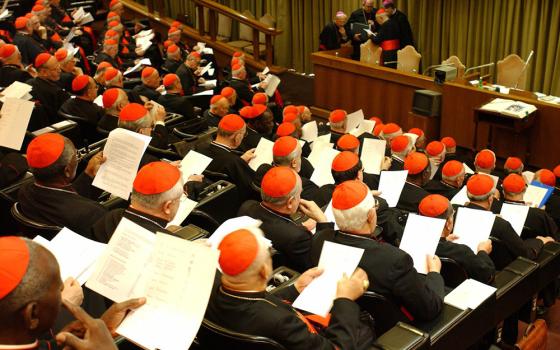A flare burns excess natural gas in the Permian Basin in Loving County, Texas, in this Nov. 23, 2019, file photo. (CNS/Reuters/Angus Mordant)
The State of the Union is usually heavily scripted, as the president lays out plans for the country. But one of President Joe Biden's most important remarks during the Feb. 7 address may have been improvised.
While talking about soaring corporate profits, he noted that the oil industry took home $200 billion in profits last year. He said executives justified this by telling him they were afraid he would shut down oil refineries anyway, so why would they invest in increasing domestic production?
"We are going to need oil for at least another decade," the president responded during the speech, earning guffaws from some in the chamber. Apparently many in the audience simply couldn't imagine a world without oil — 10 years feels so unrealistic that it must have been meant as a joke.
But the president wasn't joking. And the dire future facing young people today, with many even worried about having children because they fear an unlivable planet, is no laughing matter.
When it comes to oil production in the United States, the Biden administration has taken two, somewhat contradictory, approaches.
Advertisement
Earlier this month the administration approved a massive oil drilling project on the National Petroleum Reserve in Alaska, which is projected to produce about 600 million barrels of oil over 30 years. Opponents call the drilling plan a "carbon bomb."
At the same time, in his State of the Union address the president touted his Inflation Reduction Act as "the most significant investment ever to tackle the climate crisis."
"Let's face reality," Biden said. "The climate crisis doesn't care if your state is red or blue. It is an existential threat. We have an obligation to our children and grandchildren to confront it."
But our children and grandchildren aren't waiting for older Americans to confront the problem anymore. They are taking the matter into their own hands.
With their future uncertain and drawing inspiration and guidance from their church, young Catholics are calling on their leaders to act on the appropriate scale needed for the climate crisis.
This month, high school students in the Archdiocese of Chicago are hosting a Youth Climate Summit for their peers, connecting climate science to their Catholic faith.
And Catholic young adults now have a yearlong fellowship opportunity through the Catholic Climate Covenant — the Common Home Corps — to receive education on how best to engage church leaders on climate change and to urge concrete actions.
The Covenant has been working with parishes, congregations, bishops, sisters, pastors, young adults and volunteers to move the Catholic Church from rhetoric to action and has found hope in the church and its people.
Catholics can leverage the Inflation Reduction Act, a law indeed making the largest climate investment in U.S. history, by taking advantage of one of its most unsung aspects to date: that nonprofit organizations (including parishes and dioceses) can benefit from clean energy tax credits and make affordable, substantive change now.
The Covenant's Catholic Energies team is already helping navigate these new provisions.
These efforts and possibilities lead us to imagine a church that helps address climate change in prayer and action — as our faith asks us to do — while drawing young people back to worship along the way.
Referring to our democracy, Biden said we are at an inflection point in our nation. But a global inflection point challenges us to take a stand and act for our shared planet now.
We have an opportunity to take climate change seriously and act together for our common home and future generations. Let's not miss our chance.







